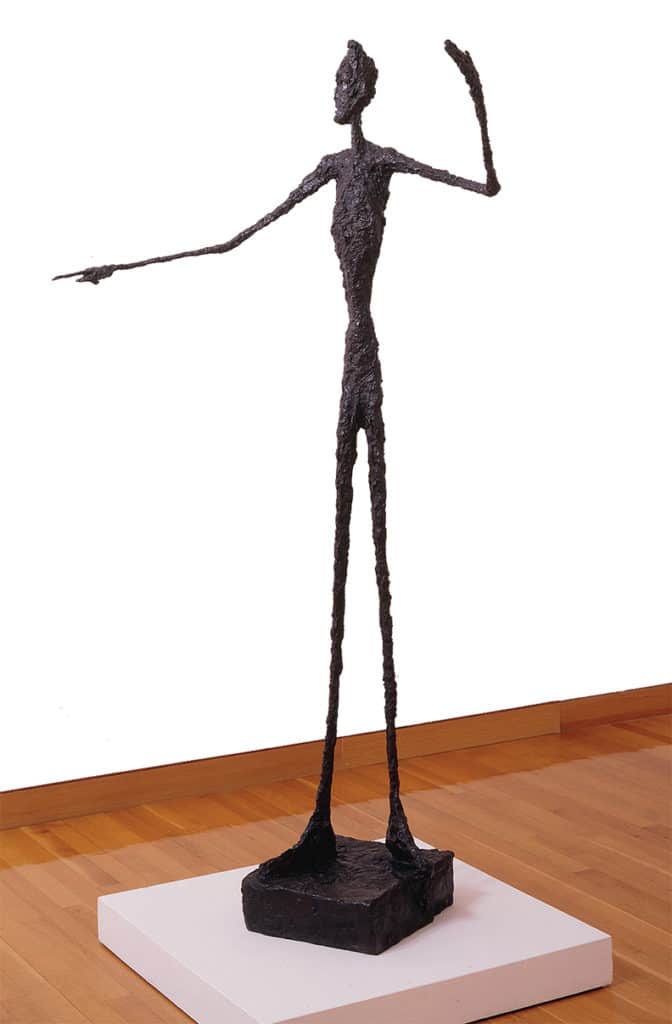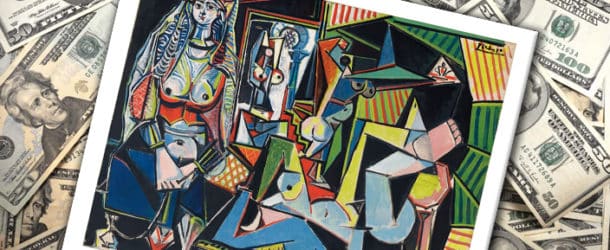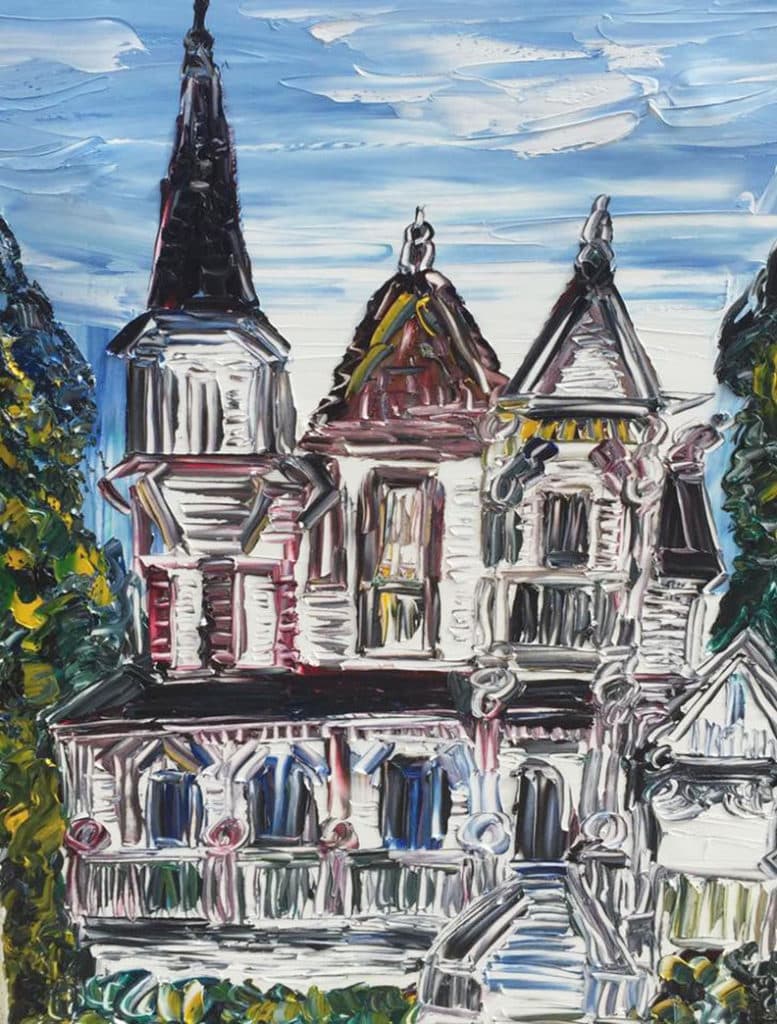Locals Invest In Art For Enjoyment, Healing, And, Sometimes, Profit
By Brad Goins
The single most common reason for buying a work of art is that the buyer simply likes the art. He’s seen an image that he enjoys the look of and that makes him feel good. He believes that the pleasure and comfort he gets from the art work is worth its price.

Giacometti’s iconic modernist sculpture L’Homme au doigt (Pointing Man) fetched $141,285,000 and a world auction record in 2015.
There’s a fascinating anecdote that drives home the point that some local buyers invest in even valuable art simply because they like it. Denise Rau, of the Rau Financial Group in Lake Charles, once bought some prints by John James Audubon. She subsequently cut them so that they would “work for the space” she’d set aside for them.
Friends could hardly believe their ears when Rau told them she’d cut Audobon prints. But one thing was for sure — she’d proven that she bought art entirely to please herself.
“I don’t buy art as an investment,” she explains. “I buy it for my own aesthetic pleasure.”
Similar motivations are very likely behind most purchases of work by local collectors. That’s especially the case when local buyers purchase works by local artists.
Denise Rau says she “doesn’t really consider herself a collector.” Perhaps one thing she means by that is that she doesn’t see the purchase of art as something that has a financial future. She’s not thinking of acquiring property that will appreciate in value.
“People have different reasons for buying art,” says Rau. “Basically I buy art for healing or pleasure … My home is about home … I like things that make me calm.”
Rau also emphasizes the potential of art works to heal, or to bring relief. She works on the board of Memorial Hospital. One of her colleagues is Leif Pederson, who lines the walls with art works meant to ease the stress of both patients and visitors. “Art is a source of healing for a lot of people,” says Rau.
The Personal Aspect
It’s often said that Lake Charles is a fairly big town that has a small town atmosphere. That being the case, it’s no surprise that many local art buyers take a personal interest in artists whose works they buy. Rau hooks right into this motive for buying art.
“I do like to have [work by] local artists … I’m about people,” she says. “It makes me happy to have [art work by] people I know and love. My house is about people and love.”
This motive is shared by Lake Charles watercolor painter artist Nancy Melton. “I tend to collect paintings from those I study with [and from] artists [whose work] I enjoy.”
Anne Dentler, the founder of the Associated Louisiana Artists’ Gallery by the Lake, is quiet specific about the personal connection that is part of much local art collecting: “The true collector is someone who gets attracted to a painter they feel something about.”
But buyers’ motives aren’t always clear — especially if the buyer doesn’t discuss them. “I’ve been at this game for 40 years, and I’m still not sure [why people buy the art they buy],” says Patsy Manuel, owner of the Frame House Gallery.
“People buy because of who that person is,” says Manuel. “You collect something that means something to you.”
Local Art And Local Culture
When I interview Manuel, she mentions the annual Louisiana Duck Stamp, which is considered a benchmark of art by many local collectors. This brings us to the iconography of Lake Area art.
Much of the art of Southwest Louisiana centers around such subjects as ducks, pelicans, breeds of dogs that are used for hunting, deer, bayous and marshes, crabs and so forth.
Obviously such art directly reflects key concerns of the culture of Southwest Louisiana. The area has a culture that places a high value on nature and waterways; hunting, fishing and other outdoor activities; and travel by water.
There’s no doubt that the sight of art one likes reduces one’s level of stress. In especially stressful moments, one is best calmed by images of what is familiar. Nature art that would evoke strong responses in Southwest Louisiana would go all but unnoticed in large urban areas in other parts of the country.
Buying Local
This state of affairs begs the question of how often a purchase of local art that brings the buyer comfort also brings him a tidy little profit down the line.
I presume that if I were to buy art as an investment, I’d be thinking that its value would appreciate considerably over a period of, say, 30 years. But can I reasonably make that assumption about some of the local art that’s most popular and best known in the area?
There’s no denying that the work of such local artists as Elton Louviere, Bob Kleinsmidt, Eddie Mormon, Candice Alexander and others can carry some pretty high price tags in the Lake Area at present. But will the reputations of these artists ever spread beyond the Lake Area? And if they do not, will whatever local reputations they have in coming decades mean increases in the value of their work?
I asked Dentler if she felt that Louviere and the other local artists would be forgotten in 75 or 100 years. She said, “it will be an even shorter period than that.” She did note that original paintings will always have some value in the future merely by virtue of being old paintings. But they won’t be sold for sums that will make even a little dent in the cost of a college education. As Rau puts it, “I think people who really collect art [to make money] are buying much different pieces.”
People may have a tendency to over-value the work of some local artists because they hear or read so much about them. But Dentler can remember a time years ago when “Elton Louviere would not be heard of in Lafayette.” Likewise, people in Lake Charles didn’t know who George Rodrigue was. (It should be emphasized that in more recent years, Lake Charles artist Candace Alexander has realized commercial success in both her home town and Lafayette.)
Of course, there’s always the possibility that some artist from Lake Charles — or any other place — will make a break and become a nationally known figure. But it’s unlikely in the extreme an artist who paints in the traditionally realistic forms that are most prized in the Lake Area would have a break out.
Any who are serious about realizing a return on an investment in regional art should, at the very least, travel to the major urban areas nearby — New Orleans, Houston, Austin, Atlanta — and see what’s selling well in these places (and what gallery owners see in the future).
A Good Return
None of that is to say buyers in Southwest Louisiana never make money with art. Since artist Nancy Melton started collecting the works of Chinese painter Lian Quan Zhen, they’ve doubled in value.
But Melton collects Zhen’s work not for financial reasons, but because she likes his art and she likes him. She’s previously brought him to Lake Charles to teach his painting techniques, which involve reducing the paint to a liquid form that he pours onto French paper. Melton is so big on Zhen that she had him do a portrait of her granddaughter.
There’s no doubt that some of the wealthier residents of Lake Charles can and do collect art works by Van Gogh or Cy Twombly or Mark Rothko that might eventually be sold for high figures — even figures well into the millions.
As for the economics of art collecting at the highest echelons, sales of art overall broke all previous records in 2015. The highlight of the year came in May, when Christie’s sold more than a billion dollars’ worth of art in a single week. That was a first.
Each of the paintings that finished in 2015’s Top 10 sold for a price greater than $50 million. Coming out on top was Pablo Picasso’s Les Femmes d’Alger (Version ‘O’), which went for $180 million. Picasso placed two other works in the Top 10.
Close behind was Modigliani’s famous Nu Couché, which went for $170 million. That work was followed by Giacomettii’s stark modernist sculpture L’homme au doigt, which went for 30 million less.
Each work in the Top 10 was created in the 20th century, with the most recent being Lucian Freud’s 1994 painting Benefits Supervisor Resting, which brought Christie’s New York a cool $56 million.
All but two of the works on the list were sold by Christie’s, which obviously had a very good year. Of course, results in future years could be very different. One thing, however, isn’t likely to change much. The prices aren’t likely to go down much, if any.
Tips For Collecting
Even if one is just buying art for personal pleasure, there’s no need to make buying decisions that diminish whatever monetary value the work does have. Anne Dentler provides some basic tips.
Dentler says the “value of originals — even bad originals — will be more valuable than any print.”
In the pre-digital age, collectors and investors generally felt that it was pretty easy to determine that a painting was original. One just looked for the brush stokes in the surface of the work. But with today’s technology, it’s possible to reproduce such features as brush strokes or piled-on paint.
There’s an easy way to identify an original. Just take the canvas off of or out of its frame. A fake painting will be the size of a perfect square. In a real painting, the paint on the canvas will extend beyond the area that winds up being shown in the displayed work.
As for numbered series, make sure the numbers aren’t going too high. As a general principal, says Dentler, when it comes to collecting, “the more there are of something, the less valuable it is.”
As for haggling over a work of art, the collector gets to set the direction. “A real collector will haggle with you,” says Dentler. “I hate to haggle.”





















Comments are closed.